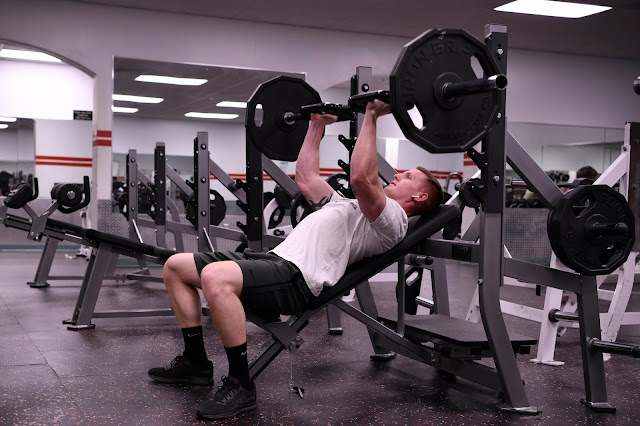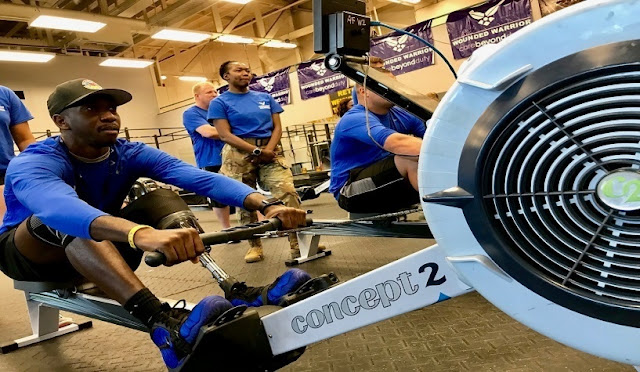Soldier trains the trainers on new Army Combat Fitness Test standards
By Steve Larson
Public Affairs Office
Sgt. 1st Class Randall Matlock was a platoon sergeant with the 1077th Ground Ambulance Company in Olathe, Kansas, when he learned the Army was looking for instructors to travel around the world, and educate Soldiers about the new Army Combat Fitness Test.
“This test is a major change in the Army and is the first step towards a culture shift for fitness and Holistic Health and Fitness,” said Matlock. “It was a first-hand opportunity to learn the ACFT and Holistic Health and Fitness and take that knowledge back to the National Guard formation.”
So, the Blackwell, Oklahoma, native applied and was accepted for the program. He was assigned to the Center for Initial Military Training in Fort Eustis, Virginia, as an Army Combat Fitness Test instructor on the Mobile Training Team.
“When I found out I was accepted, I started training,” said Matlock. “I live in a small town and there weren’t standard Army climbing pods available. There was, however, a park near my house with monkey bars that I used to train for the leg tuck event.”
Matlock said his new role is to train others on the ACFT standards and how to get in shape to meet them.
“We also certify validated graders,” Matlock added, “and support all Soldiers by producing training videos. We also do ACFT demonstrations for Army senior leaders.”
The need for trainers arose when the Army decided to replace the current Army Physical Fitness Training with the ACFT. The ACFT will become the Army’s official test of record by October 1, 2020.
“The physical demands of combat have changed as the character of war has changed,” said Matlock. “The ACFT will improve physical readiness, prevent unnecessary injuries and attrition, as well as enhance stamina and mental toughness.
“The ACFT is the result of a scientifically validated study, which identified 10 components of fitness that are the most predictive of performance on common Soldier tasks,” Matlock explained. “Those 10 components were broken down and identified into physical fitness exercises.”
Matlock said the new standards test a Soldier’s explosive power, anaerobic and aerobic endurance, muscular strength and endurance, balance, coordination, speed, and flexibility.
“The ACFT was assessed and has an 80 percent predictability for combat performance,” said Matlock. “The APFT primarily provides an assessment of muscular and aerobic endurance, but only gives a 40 percent predictability for combat performance.”
Matlock said the events for the ACFT were developed through careful study of what it takes to survive on the battlefield.
“There is a fallacy among some Soldiers that the test was developed in an ad hoc manner and that is simply not the case,” he said. “The Baseline Soldier Physical Readiness Requirements and Physical Demands Study determined the 10 components of physical fitness that will result in the success of the battlefield. Based off the BSPRRS study, the most effective fitness testing standards where developed to assess the components of combat fitness.”
“The best way I can explain how the ACFT will prepare soldiers for their mission is to speak from a medic’s point of view,” said Matlock. “As a medical platoon sergeant, one of the primary responsibilities is Soldier care, which includes understanding their strengths and weaknesses and to keep them from being injured. One of my biggest concerns over the years for my team is the possibility of injury from loading and unloading patients. I’ve witnessed medics who simply lack the lower body strength and endurance necessary to pick up a casualty on a litter.”
Matlock said one of the primary causes of such injuries is improper form due to fatigue.
“Proper lifting form tended to deteriorate after the second or third patient was loaded in the back of the ambulance, primarily due to a lack of back and leg strength and power,” said Matlock. “The ACFT will have us training in such a way that we will have more strength and endurance in our lower body, as well as increased grip strength.”
Matlock said these injuries reduce readiness and, in a deployed environment, may affect mission success.
Matlock explained that fiscal year 2019 was the field test year for the ACFT. Sixty-three battalion-sized units from all three components were used to gather data to allow Army senior leaders to determine if any changes were needed.
“During fiscal year 2020, active-duty Soldiers will take the ACFT twice, while National Guard and Reserve Soldiers will take the ACFT once, all as a diagnostic, and not for record,” said Matlock.
Matlock said training to meet the new standards does not necessarily require any special equipment.
“I like to tell a story about my deployment to Africa where I spent time with Ugandan soldiers,” said Matlock. “Obviously, being a third-world country, they were limited in resources for physical training. The soldiers started their day with a formation, followed by physical training. They would find a large stone, weighted and sized to their individual abilities, and begin by grasping those rocks at hip level and squatting to mimic the sumo squat.”
Matlock said Field Manual 7-22 (https://armypubs.army.mil/epubs/DR_pubs/DR_a/pdf/web/ARN7938_FM%207-22%20INC%20C1%20Final.pdf) has been available for over 10 years and has exercises that do not require equipment.
“I suggest doing Climbing Drills 1 and 2 twice a week,” said Matlock. “The ACFT microsite has additional training guidance and can be found at www.army.mil/acft/. We’ve also modified training for the Sprint-Drag-Carry event using a tire and rim pulled by a 92-inch rope, or you can substitute the kettle bells for two-gallon water jugs.
“Soldiers are only limited by their imaginations and access to common household materials.”
Matlock said it will be the responsibility of unit noncommissioned officers to help their Soldiers train to meet the new ACFT standards.
“NCOs must be good mentors, teachers, and coaches to be effective, not only with physical readiness training, but with all aspects of leadership,” said Matlock. “I’ve been a traditional National Guardsman my whole career, so I understand balancing work, life, and family with physical training and drill weekends. Squad or platoon level accountability for physical training in between drill weekends seems daunting with all of life’s complications.
“The simple answer is complete Physical Readiness Training during drill weekends, which solidifies the priority of physical training in your formations and fosters esprit de corps. This also gives NCOs a chance to lead from the front while coaching Soldiers on physical readiness.
“All Soldiers need proper physical training guidance, and proper accountability,” said Matlock. “NCOs should use their local Master Fitness Trainers for guidance and training programs, and to ensure training techniques are being performed to standard.
Matlock said there is not a one-size-fits-all approach in preparing Soldiers for the ACFT; every Soldier’s training needs are different, and every training plan should be individualized
Matlock reemphasized the role of NCO leadership in preparing their Soldiers to meet the new ACFT standards.
“NCOs can’t do stump speeches on the importance of physical training and not follow up with action.”
“NCOs can’t do stump speeches on the importance of physical training and not follow up with action.”




Comments
Post a Comment